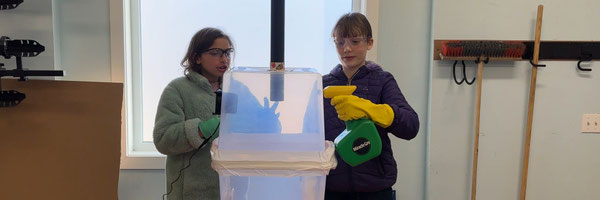A green revolution
Brooke Fehr Josephine Daskal
Grade 6
Presentation
No video provided
Problem
We found that by 2050 we have to reach net zero CO2 emissions due to the drastic change of climate and have also been observing that farmers all over the world could not keep up with produce demand due to the sudden increase in population. These are some of the biggest concerns for the world and if we want to keep living in it things have to change. For instance climate change effects the air we breath and is melting ice caps, this results in rising sea levels and increase ib temperature, and if we dont have enough food people can starve. These problems are taking over the world and with this machine we are not only creating a change in calgary but all over the world.
Method
Proceedure For Plants
Begin by first filling all 6 starter pots with soil until soil is approximately 1 inch above the lip of the starter pots.
Now wet the soil until top 3 layers are moist
Create 1-2 cm holes in the top layer of soil in each pot
Place 1-2 seeds in each hole
Now cover the seeds with excess soil
Place in sunny area or greenhouse if available
Every Tuesday, Thursday, and sunday water half of plants with 12 ml KOH and 6 ml water, water other half of plants with 12 ml of just water
Once plants are big enough replant into bigger pots and continue writing observations
Procedure For Machine
Take 1 out of 2 boxes and cut three holes,one in the middle of the top , and one in each of the short sides,the hole should be in the perimeter of the pvc pipe.
Take the two boxes (hole side up) and use expanding superglue to glue the ends of the boxes together ( make sure to get every spot or it will leak). Attach the reversible fan to the hole on the right side of the box ,make sure the fan is blowing inwards not outwards.
For every 1 quarter cup of koh add 3 quarter cup of water into the spray bottle. Start the fan and wait for a couple of second until you use the spray bottle ( so the liquid can mix). Start spraying Koh mixture into the hole opposite of the fan. Check the Co2 monitor every couple seconds and take photos of the co2 slowly decreasing. Keep on doing this process for a couple minutes and soon you will see liquid forming at the bottom of the box.
When there is a reasonable amount of liquid in the box, open the stop in the box and pour mixture into glass jar. Everyday use the glass droppers to put 10 ml Koh and 4 ml water into the koh plants and 14 ml water into the normal plants. Repeat this process for 1 to 2 months also observe changes and take photos of plants.
Analysis
During our first carbon capture experiment we observed the CO2 levels gradually declining from 1400 ppm all the way down to 480 ppm, however in the second attempt the Co2 levels began at 500 ppm and ended at 375. This drop is because of our KOH, which, once we sprayed in the air, it chemically binds with the Co2, and because the Koh is in a liquid form, once attached to the CO2 it falls, as the water droplets are heavier than the oxygen molecules, therefore, the fresh air flew out of the top of our tube, resulting in our potasium carbonate liquid which we later fed to our plants.
During our plant experiment, we have observed that our KOH plants have not grown yet. We suspect that this may be due to the amount of potasium carbonate to water ratio we fed our plants. However as recent articles have proven, KOH can increase plant growth, but as KOH in agriculture is a very new subject, we were not able to find the amount of potasium carbonate to water ratio in the time provided. However we still believe that KOH shows a strong promise for the future of agriculture.
In the future we would have liked to figure out the correct pottasium carbonate to water ratio for our plants, to help them grow faster, and prove our hypothesis entirely correct.
(ppm stands for parts per million) (potasium carbonate is the KOH and carbon combined)
Conclusion
In conclusion our hypothesis was mostly correct, we where able to create a low power consumption carbon capture device, that succesfully removed the carbon from the air. however with the time provided we were not able to find the correct ratio of KOH to water for our plants. But our reasearch does infact prve that KOH can improve the growth of a plant, as proven by resent articals and agricultral facilitys.
In the future we would like to figure out the correct Pottasium carbonate to plant formula, as we were not able to do this in the time provided.
Overall in the future this could be a revolutionary addition to farms and buildings creating a better ecosystem for our planet and everyone paving the path to reaching net-0 emmisions.
Citations
-https://climate.nasa.gov › vital-signs › carbon-dioxide
https://www.wfp.org › countries › sudan
–https://noahchemicals.com/blog/potassium-hydroxide-agriculture-industry/
–https://news.mit.edu/2019/mit-engineers-develop-new-way-remove-carbon-dioxide-air-1025#:~:text=The%20device%20is%20essentially%20a,as%20it%20is%20being%20discharged. –https://www.youtube.com/watch?v=1QLQEsReCN0
–https://education.nationalgeographic.org/resource/photosynthesis/
Acknowledgement
We would like to acknowledge Caroline fFehr (Brookes's mom) and Tamar Epstein (Josie's mom) for providing all the materials to do our project. We would also like to acknowledge our dads (Lav Daskal and David Fehr) for driving us to each other's houses. We would also like to acknowledge our teacher for guiding us throughout this project

